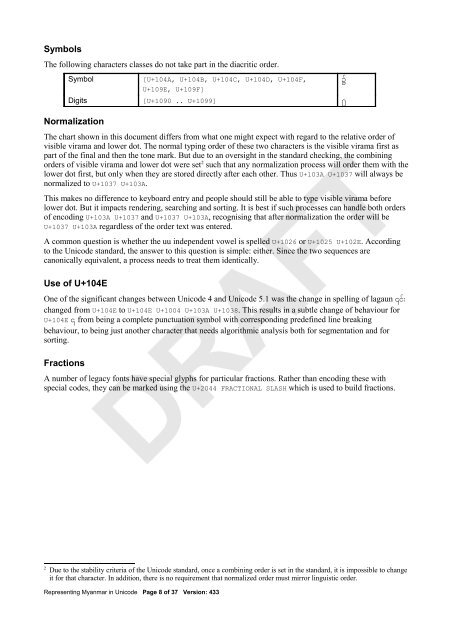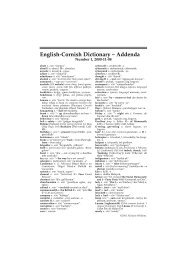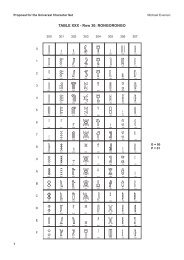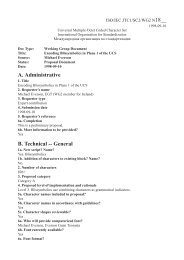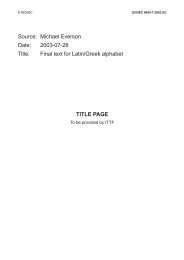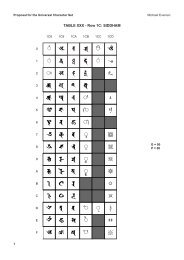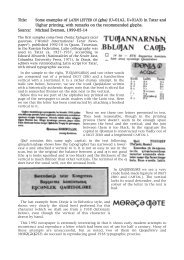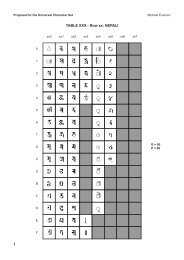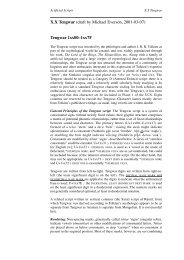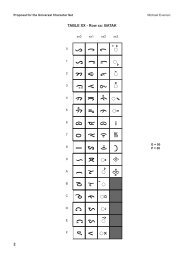Representing Myanmar in Unicode - Evertype
Representing Myanmar in Unicode - Evertype
Representing Myanmar in Unicode - Evertype
You also want an ePaper? Increase the reach of your titles
YUMPU automatically turns print PDFs into web optimized ePapers that Google loves.
Symbols<br />
The follow<strong>in</strong>g characters classes do not take part <strong>in</strong> the diacritic order.<br />
Symbol [U+104A, U+104B, U+104C, U+104D, U+104F,<br />
U+109E, U+109F]<br />
Digits [U+1090 .. U+1099] ႐<br />
Normalization<br />
The chart shown <strong>in</strong> this document differs from what one might expect with regard to the relative order of<br />
visible virama and lower dot. The normal typ<strong>in</strong>g order of these two characters is the visible virama first as<br />
part of the f<strong>in</strong>al and then the tone mark. But due to an oversight <strong>in</strong> the standard check<strong>in</strong>g, the comb<strong>in</strong><strong>in</strong>g<br />
orders of visible virama and lower dot were set 2 such that any normalization process will order them with the<br />
lower dot first, but only when they are stored directly after each other. Thus U+103A U+1037 will always be<br />
normalized to U+1037 U+103A.<br />
This makes no difference to keyboard entry and people should still be able to type visible virama before<br />
lower dot. But it impacts render<strong>in</strong>g, search<strong>in</strong>g and sort<strong>in</strong>g. It is best if such processes can handle both orders<br />
of encod<strong>in</strong>g U+103A U+1037 and U+1037 U+103A, recognis<strong>in</strong>g that after normalization the order will be<br />
U+1037 U+103A regardless of the order text was entered.<br />
A common question is whether the uu <strong>in</strong>dependent vowel is spelled U+1026 or U+1025 U+102E. Accord<strong>in</strong>g<br />
to the <strong>Unicode</strong> standard, the answer to this question is simple: either. S<strong>in</strong>ce the two sequences are<br />
canonically equivalent, a process needs to treat them identically.<br />
Use of U+104E<br />
One of the significant changes between <strong>Unicode</strong> 4 and <strong>Unicode</strong> 5.1 was the change <strong>in</strong> spell<strong>in</strong>g of lagaun ၎င်း<br />
changed from U+104E to U+104E U+1004 U+103A U+1038. This results <strong>in</strong> a subtle change of behaviour for<br />
U+104E ၎ from be<strong>in</strong>g a complete punctuation symbol with correspond<strong>in</strong>g predef<strong>in</strong>ed l<strong>in</strong>e break<strong>in</strong>g<br />
behaviour, to be<strong>in</strong>g just another character that needs algorithmic analysis both for segmentation and for<br />
sort<strong>in</strong>g.<br />
Fractions<br />
A number of legacy fonts have special glyphs for particular fractions. Rather than encod<strong>in</strong>g these with<br />
special codes, they can be marked us<strong>in</strong>g the U+2044 FRACTIONAL SLASH which is used to build fractions.<br />
2 Due to the stability criteria of the <strong>Unicode</strong> standard, once a comb<strong>in</strong><strong>in</strong>g order is set <strong>in</strong> the standard, it is impossible to change<br />
it for that character. In addition, there is no requirement that normalized order must mirror l<strong>in</strong>guistic order.<br />
<strong>Represent<strong>in</strong>g</strong> <strong>Myanmar</strong> <strong>in</strong> <strong>Unicode</strong> Page 8 of 37 Version: 433<br />
၌


